- Stage 3A Lung Cancer
- Stage 3B Lung Cancer
- Stage 3C Lung Cancer
- Understanding EGFR & PD-L1
Stage 3A (1)
Stage 3A NSCLC diagnosis is when the tumor has spread to the lymph nodes around the main airway called the trachea or near the carina, AND:
1. The tumor is 5 centimeters or less
Or
2. One or more of the following has happened:
- The lung cancer has spread to the inner lining of your lung.
- The lung cancer has spread into your bronchus but not where the main airway branches an area called the carina.
- One of the lungs has collapsed or has an inflammation as shown at the bottom of the image.
What Tests Will I Need and Why?
Blood and Imaging tests are done to understand your general health, confirm your diagnosis and determine your cancer stage.
Tissue Analysis is also typically done to determine if the cancer cells have any specific biomarkers which are critical to finding the best treatment option for you.
In Stage 3 NSCLC, doctors look for an EGFR Mutation and /or an elevated PD-L1 level.
If your treatment team has not already performed tests to determine your cancer’s features, please ask your doctor when these tests will be performed.
Re-read this summary as needed and then tap, “Compare My Treatment Options Now“. Our unique Comparison Page will help you understand your FDA-approved treatment options including, who can help you pay for your treatment, where and how each is given and what side-effects you may experience.
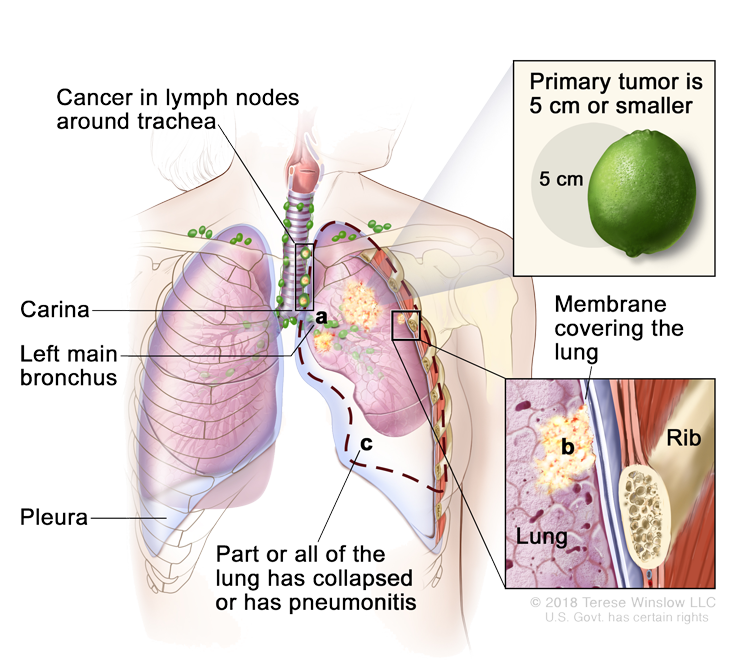
Stage 3A (2)
The lung cancer has spread to the lymph nodes on the same side your primary cancer and the affected lymph nodes are either in the lung tissue or near the airways AND:
1. The tumor is more than 5 centimeters but less than 7 centimeters.
or one or more of the following:
- You have more than one tumor on the same segment (lobule) of the lung as the primary tumor.
- The tumor is affecting the chest wall.
- The tumor is affecting a nerve in the diaphragm, called Phrenic Nerve.
- The tumor is affecting the lining of your chest wall (parietal pleura).
- The tumor is affecting the lining that surrounds the heart (pericardium).

Stage 3A (3)
The tumor is larger than 7 centimeters and/or one or more of the following has happened:
- There are more tumors in the same lung, but in different segments (lobules).
- The tumor affects the diaphragm, the space between the lungs (mediastinum), the heart, great vessels, trachea, recurrent laryngeal nerve, esophagus, vertebral bones or the carina.
Lymph nodes on the same side as the primary tumor may or may not be affected at this stage.
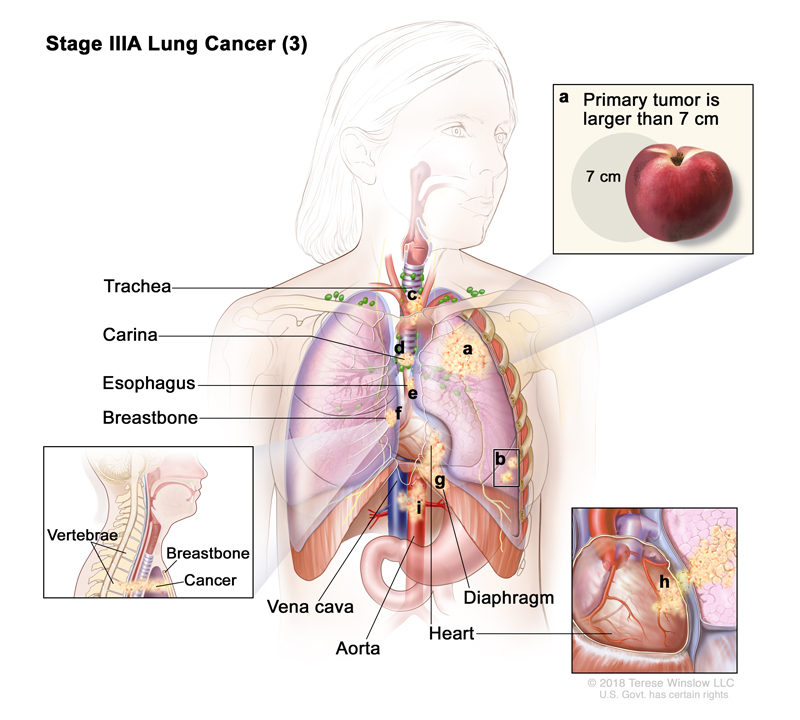
National Institute of Health/ treatment-lung
Stage 3B Lung Cancer (1)
Stage 3B (1) NSCLC diagnosis is when the tumor has spread to the lymph nodes on the opposite lung or above the collarbone, AND:
The tumor is 5 centimeters or less or, one or more of the following has happened:
- The lung cancer has spread to the inner lining of your lung.
- The lung cancer has spread into your bronchus but not where the main airway branches an area called the carina.
- One of the lungs has collapsed or has an inflammation as shown at the bottom of the image.
What Tests Will I Need and Why?
Blood and Imaging tests are done to understand your general health, confirm your diagnosis and determine your cancer stage.
Tissue analysis is also typically done to determine if the cancer cells have any specific biomarkers which are critical to finding the best treatment option for you.
In Stage 3 NSCLC, doctors look for an EGFR Mutation and an elevated PD-L1 level.
If your treatment team has not already performed tests to determine your cancer’s features, please ask your doctor when these tests will be performed.
Re-read this summary as needed and then tap, “Compare My Treatment Options Now“. Our unique Comparison Page will help you understand your FDA-approved treatment options including, who can help you pay for your treatment, where and how each is given and what side-effects you may experience.
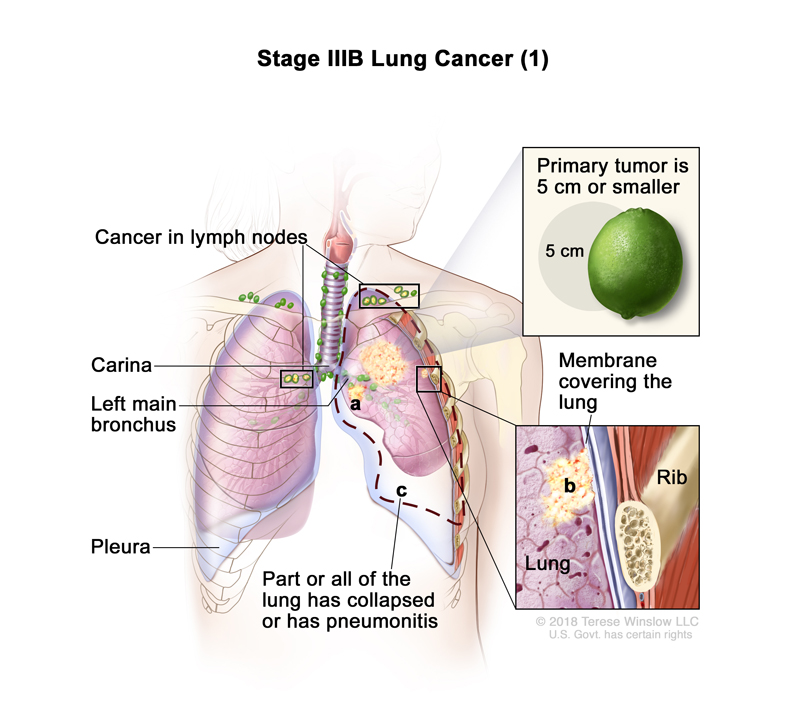
Stage 3B Lung Cancer (2)
The tumor has spread to the lymph nodes around the main airway called the trachea or near the carina, and:
1. The tumor is more than 5 centimeters but less than 7 centimeters.
And/or
2. One or more of the following:
- You have more than one tumor on the same segment (lobule) of the lung as the primary tumor.
- The tumor is affecting the chest wall, a nerve in the diaphragm, called Phrenic Nerve, the lining of your chest wall (parietal pleura) or the lining that surrounds the heart (pericardium).
Or
The tumor is larger than 7 centimeters and/or
One or more of the following has happened:
- There are more tumors in the same lung, but in different segments (lobules).
- The tumor affects the diaphragm, the space between the lungs (mediastinum), the heart, great vessels, trachea, recurrent laryngeal nerve, esophagus, vertebral bones or the carina.
What Tests Will I Need and Why?
Blood and Imaging tests are done to understand your general health, confirm your diagnosis and determine your cancer stage.
Tissue analysis is also typically done to determine if the cancer cells have any specific biomarkers which are critical to finding the best treatment option for you.
In Stage 3 NSCLC, doctors look for an EGFR Mutation and an elevated PD-L1 level.
If your treatment team has not already performed tests to determine your cancer’s features, please ask your doctor when these tests will be performed.
Re-read this summary as needed and then tap, “Compare My Treatment Options Now“. Our unique Comparison Page will help you understand your FDA-approved treatment options including, who can help you pay for your treatment, where and how each is given and what side-effects you may experience.
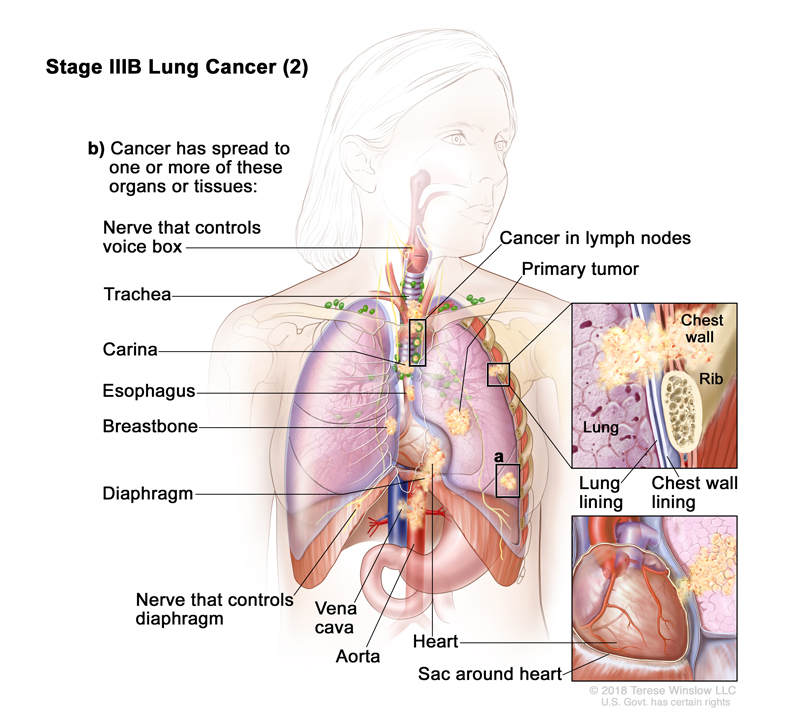
National Institute of Health/ treatment-lung
Overview
Stage 3C Non-Small Cell Lung Cancer diagnosis is when the tumor has spread to the lymph nodes on the opposite lung or above the collarbone, AND:
1. The tumor is more than 5 centimeters but less than 7 centimeters and/or,
2. One or more of the following:
- You have more than one tumor on the same segment (lobule) of the lung as the primary tumor.
- The tumor is affecting the chest wall, a nerve in the diaphragm, called Phrenic Nerve, the lining of your chest wall (parietal pleura) or the lining that surrounds the heart (pericardium).
or,
The tumor is larger than 7 centimeters and/or,
One or more of the following has happened:
- There are more tumors in the same lung, but in different segments (lobules).
- The tumor affects the diaphragm, the space between the lungs (mediastinum), the heart, great vessels, trachea, recurrent laryngeal nerve, esophagus, vertebral bones or the carina.
What Tests Will I Need and Why?
Blood and Imaging tests are done to understand your general health, confirm your diagnosis and determine your cancer stage.
Tissue analysis is also typically done to determine if the cancer cells have any specific biomarkers which are critical to finding the best treatment option for you.
In Stage 3 NSCLC, doctors look for an EGFR Mutation and an elevated PD-L1 level.
If your treatment team has not already performed tests to determine your cancer’s features, please ask your doctor when these tests will be performed.
Re-read this summary as needed and then tap, “Compare My Treatment Options Now“. Our unique Comparison Page will help you understand your FDA-approved treatment options including, who can help you pay for your treatment, where and how each is given and what side-effects you may experience.
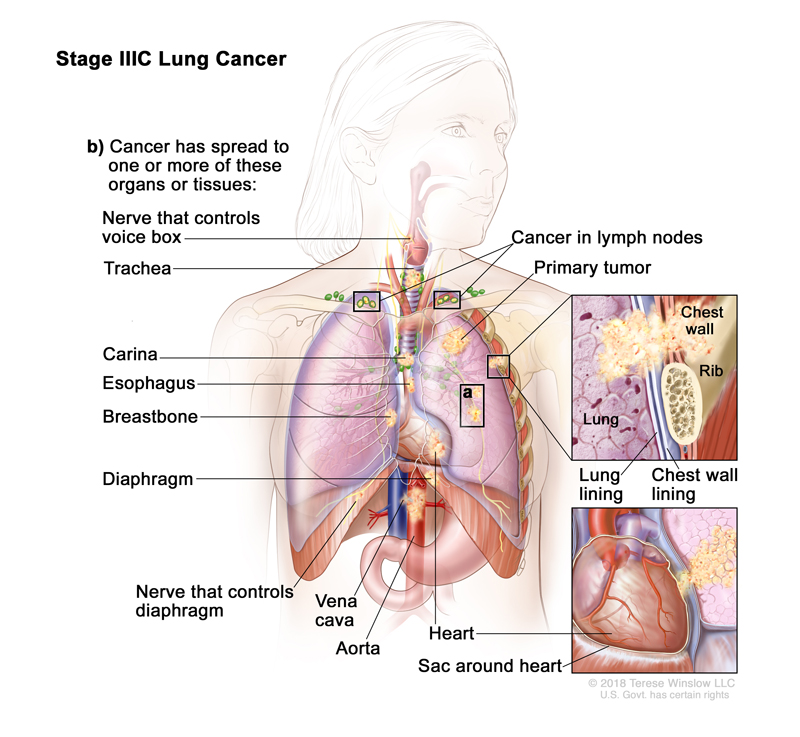
National Institute of Health/ treatment-lung
Identifying Biomarkers is critical to determining the best treatment option for you
In addition to the size and cancer stage, your lung cancer treatment options will be guided by biomarkers. Biomarkers are found in your body’s tissues or fluids. For people with Stages 1-3 NSCLC, EGFR and PD-L1 are the most common biomarkers.
EGFR-positive
EGFR (Epidermal Growth Factor Receptor) is a protein that helps your body with healthy cell growth. A mutation or abnormal change in your body’s EGFR gene can cause excessive cell growth and cancer.
There are different types of EGFR mutations that doctors look for including EGFR 19 deletion, EGFR L858R and EGFR exon 20 insertion. About 10-15% of patients with Lung Cancer have an EGFR mutation. EGFR L858R is the most common type.
If you test positive for EGFR, your treatment typically includes a medication to block EGFR, called TKI or a Tyrosine Kinase Inhibitor.
PD-L1
PD-L1 is a protein that is found in healthy cells and acts as a “brake” to keep your immune system from attacking your body’s non-harmful cells. Some cancer cells “trick” the immune system to not turn on and therefore avoid being attacked.
If your tests show cancer cells with a high level of PD-L1 ( > than 50% of the cells have PD-L1), you may benefit from immunotherapy, a treatment type that takes the “brakes” off your immune system so it will recognize and attack the cancer.
Immunotherapy is only helpful when patients do not have any other mutation such as EGFR or ALK. These patients benefit from Targeted Therapy.
Recommended Lung Cancer Videos

Understanding the Stages of Lung Cancer
Stages 1 thru Stage 4

ASK! Will Mutation Testing Help Find The Best Treatment For Me?
Knowing May Show What Drugs Will Work & What Won't!

How Cancer Spreads
Metastatic = Advanced

Diagnosing Your Cancer
How Does a PET Scan Work?

Attitude Really Matters
Get Inspired by Ann
Commonly Searched Questions
Stage 3 Non-Small Cell Lung Cancer Symptoms
- Breathlessness
- Cough for a long time
- Feeling weak
- Coughing up blood
- Weight loss
- Chest pain
- Noisy breathing
- Difficulty in swallowing
- Paraneoplastic syndrome
- Horner’s Syndrome(drooping of the eyelid and absence of sweating on one side of the face)
Source: Cancer.org
Stage 3 Non-Small Cell Lung Cancer Treatment
- Radiotherapy can be done before or after surgery.
- Chemotherapy can be done before or after surgery.
- Targeted Therapy targets the changes or mutations in cancer cells that help them grow, divide and spread.
- These are some common treatment options that are available for your Stage 3A, B and C lung cancer where surgery is not possible.
- Chemotherapy
- Immunotherapy which helps a person’s immunity identify and kill cancer can be done after Chemotherapy and radiotherapy.
- Radiotherapy
- Targeted Therapy targets the changes or mutations in cancer cells that help them grow, divide and spread.
Source: Cancer.org
Lung Cancer Stage 3 Life Expectancy
Lung Cancer Stage 3 Life Expectancy And Survival Time
According to the SEER database, the stage 3 lung cancer life expectancy has a 5-year survival rate of around 37%. This means that individuals diagnosed with stage 3 lung cancer (“regional”) have a 37% chance of surviving for at least 5 years after their diagnosis. Key Insights About Stage 3 Lung Cancer Life Expectancy: Stage 3 Lung Cancer Survival Rate: The 5-year survival rate for stage 3 lung cancer is approximately 37%, but this can vary depending on several factors, including the type of lung cancer (e.g., non-small cell lung cancer or small cell lung cancer), treatment options, and the patient’s overall health. Median Survival Time for Stage 3 NSCLC: For patients with stage 3 non-small cell lung cancer (NSCLC), the median overall survival time ranges from 9 to 34 months. This can differ based on individual characteristics, such as tumor type, location, and how the cancer responds to treatment.Source: Cancer.gov
Stage 3 Non-Small Cell Lung Cancer Recurrence Rate
Source: PubMed.gov
Stage 3 Non-Small Cell Lung Cancer Definition
Source: Cancer.org
What Is The Lung Cancer Stage 3 Survival Rate?
Lung Cancer Stage 3 Survival Rate and Life Expectancy
The lung cancer stage 3 survival rate is approximately 37% for patients diagnosed with “regional” lung cancer, according to data from the NIH SEER database.Key Information About Lung Cancer Stage 3 Survival Rate:
- What is Stage 3 Lung Cancer? Stage 3 lung cancer refers to cancer that has spread to nearby lymph nodes in the chest, and is classified as “regional” disease in the SEER system.
- Lung Cancer Stage 3 Survival Rate: The 5-year survival rate for stage 3 lung cancer is about 37%. This statistic reflects the proportion of people who live at least 5 years after diagnosis.
- Factors Affecting Lung Cancer Stage 3 Survival Rate: The survival rate can vary based on several factors, including the type of lung cancer (e.g., small cell vs. non-small cell lung cancer), tumor characteristics, and the patient’s overall health and treatment options.
Source: Cancer.org














